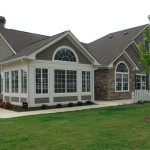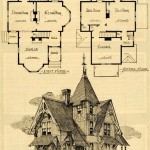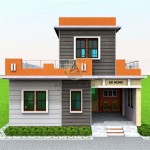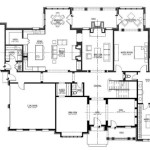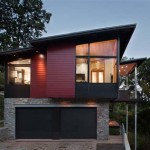A split level house floor plan is a design where the living space is divided across multiple levels, typically connected by half-flights of stairs. This type of plan creates distinct zones for living, dining, and sleeping, while maintaining a sense of flow and connection throughout the home. For instance, a split level house might have the living room and kitchen on the main level, the bedrooms and bathrooms on the upper level, and a family room or playroom on the lower level.
Split level floor plans have become increasingly popular due to their versatility and space-saving design. They offer a unique way to create varied spaces within a home, and can be particularly well-suited for sloped or uneven building sites. In the following sections, we will explore the advantages and considerations associated with split level house floor plans, and provide examples of how they can be effectively implemented in residential design.
Split level house floor plans offer a number of advantages and considerations:
- Versatile and space-saving
- Ideal for sloped building sites
- Creates distinct living zones
- Provides privacy and separation
- Enhances natural light and ventilation
- Can be less accessible than single-level homes
- May require more energy to heat and cool
- Can be more challenging to furnish and decorate
- Less suitable for individuals with mobility impairments
Overall, split level house floor plans offer a unique and functional way to create varied and connected living spaces. By carefully considering the advantages and limitations, homeowners can determine if a split level design is the right choice for their needs.
Versatile and space-saving
Split level house floor plans are highly versatile and space-saving, making them a popular choice for homeowners who want to maximize their living space without sacrificing functionality.
One of the key advantages of a split level design is that it allows for a variety of different layouts and configurations. For example, a split level home can have the living room, dining room, and kitchen on the main level, with the bedrooms and bathrooms on the upper level. Alternatively, the living room and kitchen could be on the lower level, with the bedrooms and bathrooms on the upper level. This flexibility allows homeowners to create a floor plan that perfectly suits their needs and lifestyle.
Split level floor plans are also space-saving by design. The half-flights of stairs that connect the different levels create additional storage space underneath, which can be used for closets, pantries, or playrooms. Additionally, the split level design can eliminate the need for hallways, which further saves space and creates a more open and airy feel.
Overall, the versatility and space-saving benefits of split level house floor plans make them an ideal choice for homeowners who want to create a functional and stylish home without breaking the bank.
In addition to the advantages mentioned above, split level house floor plans can also be beneficial for homeowners who have sloped or uneven building sites. By splitting the living space across multiple levels, it is possible to create a home that is level and accessible, even on challenging building sites.
Ideal for sloped building sites
Split level house floor plans are ideal for sloped building sites because they allow for the creation of a level and accessible home, even on challenging terrain. By splitting the living space across multiple levels, it is possible to create a home that is both functional and stylish, without sacrificing accessibility or comfort.
- Creates level living spaces
One of the key advantages of a split level floor plan on a sloped building site is that it creates level living spaces. This is achieved by using half-flights of stairs to connect the different levels of the home. As a result, there are no steep or uneven surfaces to navigate, making the home safe and accessible for all. - Maximizes natural light and ventilation
Another advantage of a split level floor plan on a sloped building site is that it can maximize natural light and ventilation. By placing the living spaces on different levels, it is possible to create a home that is filled with natural light and fresh air. This can help to reduce energy costs and create a more comfortable and healthy living environment. - Provides privacy and separation
Split level floor plans can also provide privacy and separation between different areas of the home. For example, the bedrooms and bathrooms can be placed on the upper level, while the living room, dining room, and kitchen can be placed on the main level. This separation can be beneficial for families with children or for those who simply want to create a more private and intimate living space. - Enhances curb appeal
Finally, a split level house floor plan can enhance the curb appeal of a home on a sloped building site. By creating a home that is visually interesting and unique, a split level floor plan can help to make a home stand out from the crowd and increase its overall value.
Overall, split level house floor plans are an ideal choice for sloped building sites. By carefully planning the layout and design of the home, it is possible to create a home that is both functional and stylish, while also maximizing the benefits of the sloped site.
Creates distinct living zones
One of the key advantages of a split level house floor plan is that it creates distinct living zones. This separation of space can be beneficial for a variety of reasons, including:
- Privacy and quiet
Split level floor plans can provide privacy and quiet for different members of the household. For example, the bedrooms and bathrooms can be placed on the upper level, while the living room, dining room, and kitchen can be placed on the main level. This separation can be beneficial for families with children or for those who simply want to create a more private and intimate living space. - Different activities
Split level floor plans can also accommodate different activities in different parts of the home. For example, the lower level can be used for a family room or playroom, while the main level can be used for more formal entertaining. This separation of space can help to create a more organized and efficient home. - Natural light and ventilation
Split level floor plans can also be designed to maximize natural light and ventilation in different parts of the home. For example, the living room and dining room can be placed on the main level, where they can benefit from large windows and sliding glass doors. The bedrooms and bathrooms can be placed on the upper level, where they can benefit from cross-ventilation.
Overall, the ability of a split level house floor plan to create distinct living zones is one of its key advantages. This separation of space can provide privacy, quiet, and different activities, while also maximizing natural light and ventilation.
In addition to the benefits mentioned above, split level house floor plans can also be beneficial for families with children of different ages. For example, the younger children can be given bedrooms on the lower level, while the older children can be given bedrooms on the upper level. This separation can help to create a more peaceful and harmonious home environment.
Provides privacy and separation
Split level house floor plans can provide privacy and separation for different members of the household, which can be beneficial for a variety of reasons.
- Separate sleeping and living areas
One of the most common ways that split level floor plans provide privacy and separation is by separating the sleeping and living areas of the home. For example, the bedrooms and bathrooms can be placed on the upper level, while the living room, dining room, and kitchen can be placed on the main level. This separation can be beneficial for families with children or for those who simply want to create a more private and intimate living space. - Separate spaces for different activities
Split level floor plans can also be used to create separate spaces for different activities. For example, the lower level can be used for a family room or playroom, while the main level can be used for more formal entertaining. This separation of space can help to create a more organized and efficient home. - Separate spaces for different generations
Split level floor plans can also be beneficial for families with multiple generations living under one roof. For example, the upper level can be used for the bedrooms and bathrooms of the older generation, while the main level can be used for the bedrooms and bathrooms of the younger generation. This separation can help to create a more peaceful and harmonious home environment. - Separate spaces for work and play
Split level floor plans can also be used to create separate spaces for work and play. For example, the lower level can be used for a home office or study, while the main level can be used for more family-oriented activities. This separation of space can help to create a more productive and relaxing home environment.
Overall, the ability of a split level house floor plan to provide privacy and separation is one of its key advantages. This separation of space can be beneficial for a variety of reasons, including creating a more private and intimate living space, accommodating different activities, and providing separate spaces for different generations or for work and play.
Enhances natural light and ventilation
Split level house floor plans can be designed to enhance natural light and ventilation in different parts of the home. This can be achieved through the use of large windows, sliding glass doors, and skylights. By carefully placing these elements, it is possible to create a home that is filled with natural light and fresh air.
One of the key advantages of a split level floor plan is that it allows for the creation of multiple levels of living space. This can be beneficial for maximizing natural light and ventilation, as it allows for windows and doors to be placed on different levels of the home. For example, the living room and dining room can be placed on the main level, where they can benefit from large windows and sliding glass doors. The bedrooms and bathrooms can be placed on the upper level, where they can benefit from cross-ventilation.
In addition to the use of windows and doors, skylights can also be used to enhance natural light and ventilation in a split level home. Skylights can be placed in the roof of the home, allowing for natural light to enter the interior spaces. This can be particularly beneficial in areas of the home that do not have access to windows, such as hallways and bathrooms.
Overall, the ability of a split level house floor plan to enhance natural light and ventilation is one of its key advantages. By carefully placing windows, doors, and skylights, it is possible to create a home that is filled with natural light and fresh air, which can help to reduce energy costs and create a more comfortable and healthy living environment.
In addition to the benefits mentioned above, natural light and ventilation can also have a positive impact on the health and well-being of the occupants of a home. Natural light has been shown to improve mood, increase productivity, and reduce stress levels. Ventilation can help to improve air quality and reduce the risk of respiratory problems.
Can be less accessible than single-level homes
One of the potential drawbacks of a split level house floor plan is that it can be less accessible than a single-level home. This is because split level homes typically have stairs connecting the different levels of the home, which can be difficult or impossible to navigate for people with mobility impairments.
- Stairs can be difficult to navigate
The primary reason why split level homes can be less accessible than single-level homes is the presence of stairs. Stairs can be difficult or impossible to navigate for people with mobility impairments, such as those who use wheelchairs or walkers. Additionally, stairs can be dangerous for young children and elderly adults, who may be more likely to fall.
- Lack of elevators
Another reason why split level homes can be less accessible than single-level homes is the lack of elevators. Elevators can provide a safe and convenient way for people with mobility impairments to move between different levels of a home. However, elevators are not typically found in split level homes, as they can be expensive to install and maintain.
- Limited accessibility features
In addition to the lack of stairs and elevators, split level homes may also have other accessibility limitations. For example, the doorways and hallways may be too narrow for wheelchairs to pass through. The bathrooms may not be equipped with accessible features, such as grab bars and roll-in showers. These limitations can make it difficult or impossible for people with mobility impairments to live comfortably in a split level home.
- Difficult to modify for accessibility
Finally, split level homes can be difficult to modify for accessibility. This is because the structural changes required to make a split level home accessible, such as installing an elevator or widening doorways, can be extensive and expensive.
Overall, the reduced accessibility of split level homes is an important consideration for people with mobility impairments. It is important to carefully weigh the benefits and drawbacks of a split level floor plan before making a decision about whether or not it is the right choice for your needs.
May require more energy to heat and cool
Split level house floor plans may require more energy to heat and cool than single-level homes. This is because the different levels of the home create separate thermal zones, which can be difficult to regulate evenly. Additionally, the increased surface area of a split level home can lead to greater heat loss and gain.
One of the key factors that contribute to the increased energy consumption of split level homes is the presence of stairs. Stairs create a natural convection current, allowing warm air to rise and cold air to sink. This can make it difficult to maintain a consistent temperature throughout the home, as the upper levels tend to be warmer than the lower levels. To compensate for this, homeowners may need to use more energy to heat the lower levels and cool the upper levels.
Another factor that can contribute to the increased energy consumption of split level homes is the increased surface area. Split level homes typically have more exterior walls and windows than single-level homes. This increased surface area can lead to greater heat loss and gain, as heat can escape through the walls and windows during the winter and enter the home during the summer.
To reduce the energy consumption of a split level home, it is important to take steps to improve the insulation and air sealing of the home. This can be done by adding insulation to the walls, attic, and basement, and by sealing any air leaks around windows, doors, and other openings. Additionally, it is important to use energy-efficient heating and cooling systems, and to set the thermostat to a moderate temperature.
Overall, split level house floor plans may require more energy to heat and cool than single-level homes. By taking steps to improve the insulation and air sealing of the home, and by using energy-efficient heating and cooling systems, homeowners can reduce the energy consumption of their split level home.
Can be more challenging to furnish and decorate
Split level house floor plans can be more challenging to furnish and decorate than single-level homes. This is because the different levels of the home create separate spaces that need to be furnished and decorated in a cohesive way. Additionally, the unique architectural features of split level homes, such as stairs and half-walls, can make it difficult to find furniture and dcor that fits well.
- Furniture placement can be difficult
One of the biggest challenges of furnishing a split level home is finding furniture that fits well in the different spaces. The different levels of the home can make it difficult to create a cohesive flow between the different rooms. Additionally, the stairs and half-walls can create awkward spaces that can be difficult to furnish. - Decorating can be challenging
Decorating a split level home can also be challenging. The different levels of the home can make it difficult to create a. Additionally, the unique architectural features of split level homes can make it difficult to find dcor that complements the home’s style. - Lighting can be difficult
Lighting a split level home can also be challenging. The different levels of the home can create shadows and dark spots. Additionally, the stairs and half-walls can block natural light from entering the home. To compensate for this, homeowners may need to use more artificial light, which can increase energy consumption. - Clutter can be a problem
Clutter can be a problem in any home, but it can be especially problematic in a split level home. The different levels of the home can create multiple spaces for clutter to accumulate. Additionally, the stairs and half-walls can make it difficult to keep clutter out of sight.
Overall, split level house floor plans can be more challenging to furnish and decorate than single-level homes. However, by carefully planning the layout of the home and choosing furniture and dcor that complements the home’s style, it is possible to create a beautiful and functional split level home.
Less suitable for individuals with mobility impairments
Split level house floor plans are less suitable for individuals with mobility impairments because of the presence of stairs. Stairs can be difficult or impossible to navigate for people who use wheelchairs or walkers. Additionally, stairs can be dangerous for young children and elderly adults, who may be more likely to fall.
In addition to the stairs, split level homes may also have other accessibility limitations. For example, the doorways and hallways may be too narrow for wheelchairs to pass through. The bathrooms may not be equipped with accessible features, such as grab bars and roll-in showers. These limitations can make it difficult or impossible for people with mobility impairments to live comfortably in a split level home.
Another challenge for individuals with mobility impairments in a split level home is the lack of elevators. Elevators can provide a safe and convenient way for people with mobility impairments to move between different levels of a home. However, elevators are not typically found in split level homes, as they can be expensive to install and maintain.
Finally, split level homes can be difficult to modify for accessibility. The structural changes required to make a split level home accessible, such as installing an elevator or widening doorways, can be extensive and expensive. For these reasons, split level house floor plans are less suitable for individuals with mobility impairments.
Individuals with mobility impairments who are considering a split level home should carefully weigh the benefits and drawbacks before making a decision. It is important to consider the accessibility needs of all members of the household, and to make sure that the home can be modified to meet those needs.










Related Posts

